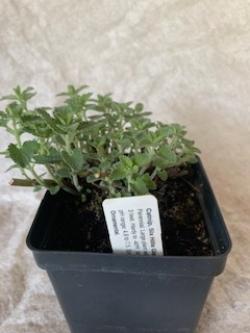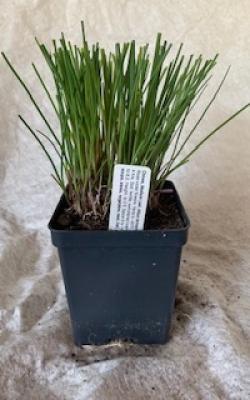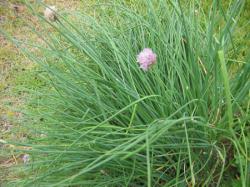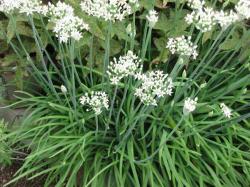Your search for Herbs begining with the letter C returned 13 items.
A | B | C | D | E | F | G | H | I | J | K | L | M | N | O | P | Q | R | S | T | U | V | W | X | Y | Z
Catmint.
Nepeta mussinii. Perennial, hardy to -40°F. Dwarf catmint with blue flowers and small gray leaves. A lovely ornamental 18 to 24 inches high. Minimally attractive to cats. A pleasant tea can be made from the flower heads and leaves.Last Seed Source: www.johnnyseeds.com
Catnip.
Nepeta cataria. Perennial, hardy to -40°F. With its three-foot height, this catnip is formidable. It shows its mint heritage in a spreading, non-invasive habit. It has large green leaves and white flowers. Kitty's helpless attraction to catnip is comical and harmless. Less well known is the pleasant tea made from the flower heads and leaves. Use to flavor meat, vegetables, and for cat toys.Last Seed Source: www.johnnyseeds.com
Catnip, Lemon.
Nepeta cataria 'Citriodora'. Perennial, hardy to at least -40°F. Similar to Tall White catnip but with a lemon scent. Kitty's helpless attraction to catnip is comical and harmless. Good for teaLast Seed Source: www.ivygarth.com
Chamomile, German.
Matricaria recutita. Annual about 18 to 30 inches high. Hardy to 29°F. Pinch young plants to promote branching and more flowers. Cut flowers frequently to keep plant vegetative. Use the flower heads in tea and in a decoction as a hair rinse. This is the best chamomile for tea. Best when planted on fertile, well-drained soils in a site with at least 4 hours of direct sun.Last Seed Source: www.johnnyseeds.com
Chamomile, Roman.
Chamaemelum nobile. Low growing perennial ground cover hardy to -40°F. Height 10 to 12 inches in flower. Sometimes called English chamomile because of its association with the gardens and lawns of that country. Keep plants amply watered during dry summers. Mowing or frequent trimming retards flowering and encourages spreading.Last Seed Source: www.johnnyseeds.com
Chervil, Brusells Type.
Anthriscus cerefolium. Annual, hardy below 20°F. Height to 2 feet (in flower). Its penchant for cool weather makes chervil a spring and winter herb in our climate. It is at its best grown in a cold frame over winter. Summer shade will help moderate temperatures. Foliage should be cut often for use, even when plants are small. Chervil is sometimes called "gourmet parsley" because of its resemblance to curly parsley and the fondness in which French cooks hold it. One of the fines herbes of the Gallic kitchen.Last Seed Source: www.johnnyseeds.com
Chives.
Allium schoenoprasum 'Purly'. Hardy to -40°F. The traditional chive with thin, tubular leaves. Plants develop into clumps which should be divided every three to four years. Cut snippets from the plants often. Remove rosy flower heads in late spring before seeds develop to eliminate seed scattering problems. Flowers can be used in chive-blossom vinegar. Foliage is used in soups, stews, vegetables, meat, fish, and eggs.Last Seed Source: www.johnnyseeds.com
Chives, Garlic.
Allium tuberosum. Sometimes called Chinese chives. This mild, garlic flavored chive develops flat, broad leaves as it matures. Although the roots are hardy to - 40°F, the tops will die down to the ground at the onset of cold weather. Plants develop into clumps which should be divided every three to four years. Cut snippets from the plants often. Remove flower heads before seeds develop to eliminate seed scattering problems. White flowers produce seed pods which can be pickled and used like capers. Foliage is used in a wide array of dishes including soups, stews, vegetables, meat, fish, and eggs.Last Seed Source: www.johnnyseeds.com
Cilantro (Coriander).
Coriandrum sativum 'Caribe'. Short-lived annual, hardy to 25-30°F. Height to 36 inches. Whether you call it cilantro or coriander may depend on how you use it. Cilantro, also dubbed "Chinese parsley", is cultivated for is aromatic foliage and used in Asian and Latin American dishes. Cilantro seeds (coriander) are used in baking and in a variety of vegetable and meat recipes. One of the most frequently asked questions here at the greenhouse is, "why is cilantro so difficult to grow?". Cilantro is no more difficult to grow than any other herb. Cilantro is a short-lived annual with two growth stages: the first is vegetative and the second is devoted to flower and seed production. The vegetative stage lasts up to 60 days, and is enhanced by regular cutting of foliage every 7- 10 days during periods of rapid growth. The appearance of fine, lacy foliage indicates the beginning of the flowering stage and the production of coriander seed. At this point the foliage becomes very bitter. Hot summer weather causes the plant to grow faster and go to seed sooner than during cooler periods. In order to have fresh cilantro all summer, successive crops 2-3 weeks apart, must be grown.Last Seed Source: www.johnnyseeds.com
Coriander, Mexican/ Culantro.
Eryngium foetidum. Biennial. Sometimes called culantro. Unusual, thorny leaves with strong cilantro flavor. Use leaves like cilantro. Two year-old roots can be harvested in autumn and used fresh. Culantro is a bit finicky to propagate, especially early in the season.Last Seed Source: www.tradewindsfruit.com




